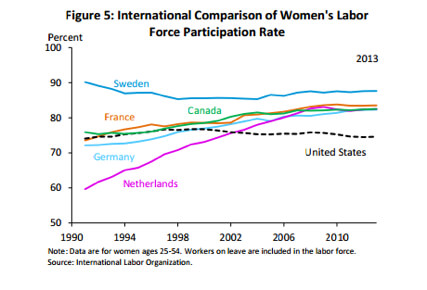Violence against women costs the United States about $4.9 billion per year. The indirect costs are, of course, exponentially higher.
When appeals to fairness and humanity fall on deaf ears, an economic case can be persuasive.
A new report released by the McKinsey Global Institute explains that reducing gender inequality in America would net trillions of dollars in terms of GDP. The headlines in major news outlets read, “There’s a $2 Trillion GDP Boost in Shrinking the U.S. Gender Gap.” The McKinsey report highlights six indicators of gender inequality that are high or extremely high in the United States and should be prioritized in terms of action. Those are: the lack of women in leadership and managerial positions and political representation, the fact that women disproportionately take on the unpaid work of caring for family members, the percentage of women who are single mothers, the rate of teenage pregnancy, and violence against women.
The report confirms that putting policies in place that encourage women’s full participation in the workforce is good economic policy. Moreover, the $2.1 trillion figure only tells part of the story: eliminating gender inequality in America could add as much as $4.3 trillion to GDP. That’s about 1/5 of our national debt. (According to one of the report’s authors, the group highlighted the smaller number because they didn’t think true equality was “realistic”.)
Around the world countries are recognizing the value of advancing gender parity. As we have previously highlighted on this blog, in 2013, Prime Minister Shinzo Abe championed “Womenomics” as a potential solution to the economic growth problem caused by Japan’s stagnating population. Abe pledged to institute policies to increase women’s participation in the workforce including the creation of 400,000 new day-care centers by 2018. Beginning this month, Japanese companies with 301 employees or more are required to set numerical targets for the percentage of female hires and managers. The Wall Street Journal reports that several European countries, including Germany and France, have implemented quotas for female board members.
Still, touting the economic benefits of gender parity is not how most business and political leaders in this country talk about so-called “Women’s Issues”. Of the four leading candidates in this year’s Presidential race, only Hillary Clinton has framed closing the gender pay gap, addressing violence against women, providing paid family leave, and protecting reproductive rights as “economic issues, and crucial to our future competitiveness.”
They are.
According to the White House Council of Economic Advisors, “Today, our economy is 13.5 percent larger than it would be if women were employed at the same rate and worked the same number of hours that they did in 1970. That’s an additional $2.0 trillion in GDP due to the increased attachment of women to the labor force…” Unfortunately, however, women’s participation in the workforce has stagnated in recent decades. The CEA notes: “In 1990, the United States ranked 7th among 24 developed countries in women’s labor force participation, but by 2012, the United States had fallen to the 16th position.”

There is a strong economic case for gender parity. However, as President Obama has said when speaking about the gender pay gap: “Ultimately, though, [it] isn’t just an economic issue for millions of Americans and their families, it’s a question of who we are — and whether we’re truly living up to our fundamental ideals.”
Women have long made up more than half of the US population. Women are 57% of college students, 47% of the American labor force, and because women are often responsible for household buying, women drive the vast majority of consumer spending in this country. Women are not a fringe group and women’s priorities are not fringe priorities: “Too often, these are called women’s issues,” Clinton’s campaign website notes. “Well, I am a proud lifelong fighter for women’s issues, because I firmly believe what’s good for women is good for America.” It’s a statement simultaneously bold, and proven in more ways than one.








